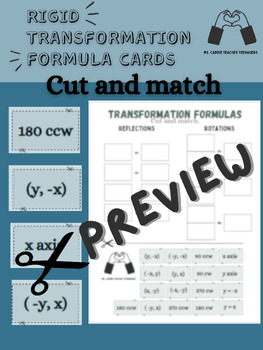Matching Rigid Transformation Formulas
Ms Caddie Teaches Teenagers
3 Followers
Resource Type
Standards
CCSSHSG-CO.A.2
CCSSHSG-CO.A.4
CCSSHSG-CO.A.5
CCSSHSG-CO.B.6
Formats Included
- PDF
Pages
2 pages
Ms Caddie Teaches Teenagers
3 Followers
Description
Matching rigid motion formulas
Objectives: To understand and memorize the formulas for rigid motions in geometry on a coordinate plane, including rotations and reflections.
- Rotations: 90, 180, and 270 degrees counterclockwise (ccw) and clockwise (cw)
- Reflections: x-axis, y-axis, y=x, and y= -x
Directions:
- Cut out all formulas and transformation descriptions and organize into zip lock bags.
- For the first day I give 1 ziplock to a pair of students and ask them to organize the formulas in the most logical way to them and then model the organization onto the board.
- Second day each student receives a ziplock and attempts to organize the formulas on their own.
- I use this as a quick activity throughout the unit of transformation and show students that it will be the first question on their test to help promote studying of formulas (I print a lot of extras and provide them to students to cut out and use to study at home)
Like this product? Check out another:
Total Pages
2 pages
Answer Key
Included
Teaching Duration
30 minutes
Report this resource to TPT
Reported resources will be reviewed by our team. Report this resource to let us know if this resource violates TPT’s content guidelines.
Standards
to see state-specific standards (only available in the US).
CCSSHSG-CO.A.2
Represent transformations in the plane using, e.g., transparencies and geometry software; describe transformations as functions that take points in the plane as inputs and give other points as outputs. Compare transformations that preserve distance and angle to those that do not (e.g., translation versus horizontal stretch).
CCSSHSG-CO.A.4
Develop definitions of rotations, reflections, and translations in terms of angles, circles, perpendicular lines, parallel lines, and line segments.
CCSSHSG-CO.A.5
Given a geometric figure and a rotation, reflection, or translation, draw the transformed figure using, e.g., graph paper, tracing paper, or geometry software. Specify a sequence of transformations that will carry a given figure onto another.
CCSSHSG-CO.B.6
Use geometric descriptions of rigid motions to transform figures and to predict the effect of a given rigid motion on a given figure; given two figures, use the definition of congruence in terms of rigid motions to decide if they are congruent.


